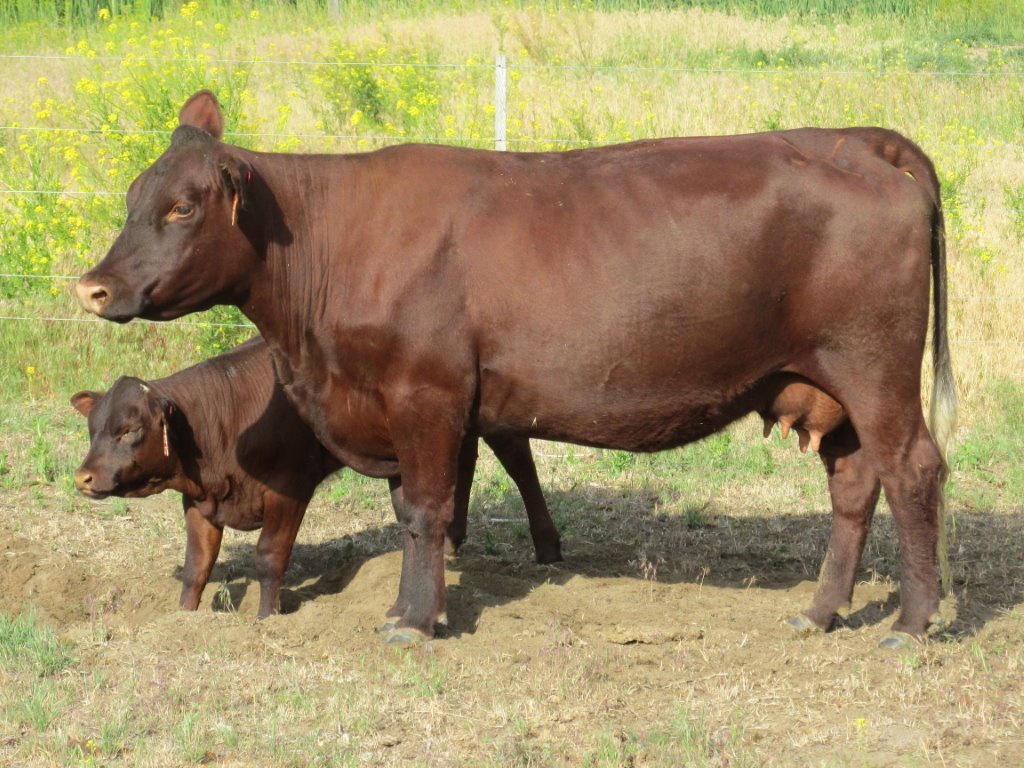WHY SUSSEX?
Sussex Breed Features
A Bos Indicus blood factor helps in withstanding both winter and summer conditions with long, curly dark red hair in the winter to soak up heat from the sun and short, smooth, insect resistant hair for the summer. No fly tags are needed in most areas; black eyelashes and red pigmentation around the eyes reduces sunburn and resists flies. Pink noses and dark red pigmentation around udders eliminates snowburn and sunburn. Udders placed well on cows and have excellent milk quality. Black, hard hooves creates resistance for traveling conditions. Correct bone structure reduces lameness and therefore makes it easier to travel long distances to water. Sussex cattle tend to have a longevity of 10-13 years. The conversion ratio on a dray matter basis runs from 5 to 6.5, depending on feeds, age and gender of the cattle. Even grazers make these cattle suitable for small, large and estate type cattle operations because they are not picky eaters.

Sussex Breed History
Sussex cattle are generally accepted as being descended from the red cattle that inhabited the dense forests of the Weald land of Sussex and Kent, on the south coast of England, and were recorded at the time of the Norman Conquest in 1066.
The almost complete absence of records prior to the eighteenth century makes it impossible to establish with accuracy the origin of the breed, but one of the earliest references to purebred Sussex cattle that we have found is contained in Arthur Young’s “Agriculture in Sussex” dated 1793. He made mention that the Sussex breeders’ ideas ran strongly in favor of a dark red color; and that the Sussex are remarkable for the fineness of their hides as they are for the closeness and delicacy of their flesh.
Society documents give details of Sussex calves registered since 1840. The first official herd book was published in 1879, and the Sussex Cattle Society as it is today was incorporated under the Companies Act in 1890.
The special characteristics of the Sussex have developed from the soil and environment of their breeding over many hundreds of years. Up to a century ago their ancestors were employed regularly as draught oxen, being reared to move wit rapidity over their native hills and through the heavy wealden clays of south eastern England. The cattle were renowned for their ease of feeding and great weight of beef.
Selection through the ages has resulted in an animal of superior carriage and constitution combined with firm muscling, good feed, and strong legs.
Over more recent decades, breeders of Sussex cattle have evolved a carcass conformation aimed at producing a maximum of prime meat whilst retaining the inherent genetic qualities of the breed.
The Sussex have the ability to produce profitable amounts of lean meat on a minimum input diet. They have early sexual maturity and the ability to breed regularly over a long life span. Lock Knelle 2nd – probably the greatest Sussex cow ever – lived to 15 years and produced 12 live calves. In 1928, 1929, 1930, 1931, 1932, and 1939, aged 13, we was awarded supreme championships at the Royal Show. The Sussex has a docile temperament and is easy to handle and manage in feed lots. They have proven ability to transmit these factors to their progeny when crossed with other breeds.
All these factors can be substantiated over many decades in many parts of the world, including southern Africa, where they have bene the predominant beef breed since the early 1900’s.
Since 1931 the Breed Society have been engaged in a natural de-horning program under the original advice of Sir John Hammond of Cambridge University – at that time the world’s leading cattle geneticist. The cross used was Red Angus, which have long since been bred out and polled cattle now compete on equal terms with dehorned and have won innumerable prizes in the show ring, including championships at the Royal Show.
